|

by John Burrows
India, according to Dr.V. Raghavan, retired head of the
Sanskrit department of India's prestigious University of
Madras, was alone in playing host to extraterrestrials in
prehistory. Dr. Raghavan contends that centuries-old documents in
Sanskrit (the classical language of India and Hinduism) prove that
aliens from outer space visited his nation.
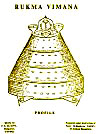 "Fifty years of researching this ancient works convinces me that
there are livings beings on other planets, and that they visited
earth as far back as4,000 B.C.", the scholar says. "Fifty years of researching this ancient works convinces me that
there are livings beings on other planets, and that they visited
earth as far back as4,000 B.C.", the scholar says.
"There is a just a mass of fascinating information about flying
machines, even fantastic science fiction weapons, that can be
found in translations of the Vedas (scriptures), Indian epics,
and other ancient Sanskrit text".
In the Mahabharata (writings), there is notion of divine
lighting and ray weapons, even a kind of hypnotic weapon.
And in the Ramayana (writings), there is a description of
Vimanas, or flying machines, that navigated at great heights with
the aid of quicksilver and a great propulsive wind.
"These were space vehicles similar to the so-called flying saucers
reported throughout the world today. The Ramayana
even describes a
beautiful chariot which 'arrived shining, a wonderful divine car
that sped through the air'. In another passage, there is mention of
a chariot being seen 'sailing overhead like a moon' ".
The references in the Mahabharata are no less astounding:
- At Rama`s behest, the magnificent chariot rose up to a
mountain of cloud with a tremendous din. Another passage reads: Bhima flew with his Vimana on an enormous ray which was as brilliant
as the sun and made a noise like the thunder of a storm.
- In the ancient Vymanka-Shastra (science of aeronautics), there
is a description of a Vimana: "An apparatus which can go by its own
force, from one place to place or globe to globe".
- Dr. Raghavan points out, "The text's revelations become
even more astounding. Thirty-one parts-of which the machine
consists-are described, including a photographing mirror underneath.
The text also enumerates 16 kinds of metal that are needed to
construct the flying vehicle: `Metals suitable, lighare 16 kinds`.
But only three of them are known to us today. The rest remain
untranslatable."
- Another authority who agrees with Dr. Raghavan`s
interpretations is Dr. A.V. Krishna Murty, professor of
aeronautics at the Indian Institute of Science in Bangalore. "It is
true," Dr. Krishna Murty says, "that the ancient
Indian Vedas and other
text refer to aeronautics, spaceships, flying machines, ancient
astronauts. "A study of the Sanskrit texts has convinced me that
ancient India did know the secret of building flying machines-and
that those machines were patterned after spaceships coming from
other planets."
The Vedic traditions of India tell us that we are now in the
Fourth Age
of mankind. The Vedas call them the "The Golden Age", "The Silver
Age", and "The Bronze Age" and we are now, according to their
scriptures in the "The Iron Age". As we approach the end of the 20th
century both Native Americans, Mayans, and Incans, prophecies claim
that we are coming to the end of an age. Sanskrit texts are filled
with references to Gods who fought battles in the sky using Vimanas
equipped with weapons as deadly as any we can deploy in these more
enlightened times.
For example, there is a passage in the Ramayana which reads:
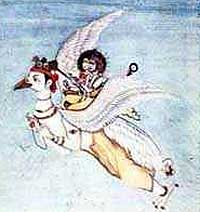 The Puspaka car that resembles the Sun and belongs to my brother
was brought by the powerful Ravan; that aerial and excellent
car going everywhere at will.... that car resembling a
bright cloud in the sky. ".. and the King [Rama] got
in, and the excellent car at the command of the Raghira,
rose up into the higher atmosphere." The Puspaka car that resembles the Sun and belongs to my brother
was brought by the powerful Ravan; that aerial and excellent
car going everywhere at will.... that car resembling a
bright cloud in the sky. ".. and the King [Rama] got
in, and the excellent car at the command of the Raghira,
rose up into the higher atmosphere."
In the Mahabharata, an ancient Indian poem of enormous length, we
learn that an individual named Asura Maya had a Vimana measuring
twelve cubits in circumference, with four strong wheels. The poem is
a veritable gold mine of information relating to conflicts between
gods who settled their differences apparently using weapons as
lethal as the ones we are capable of deploying.
Apart from 'blazing missiles', the poem records the use of other
deadly weapons. 'Indra's Dart' operated via a circular 'reflector'.
When switched on, it produced a 'shaft of light' which, when focused
on any target, immediately 'consumed it with its power'. In one
particular exchange, the hero, Krishna, is pursuing his enemy,
Salva, in the sky, when Salva's Vimana, the Saubha is made invisible
in some way. Undeterred, Krishna immediately fires off a special
weapon: 'I quickly laid on an arrow, which killed by seeking out
sound'.
Many other terrible weapons are described, quite matter of fact, in
the Mahabharata, but the most fearsome of all is the one used
against the Vrishis. The narrative records:
Gurkha flying in his swift and powerful Vimana hurled against the
three cities of the Vrishis and Andhakas a single projectile charged
with all the power of the Universe. An incandescent column of smoke
and fire, as brilliant as ten thousands suns, rose in all its
splendor. It was the unknown weapon, the Iron Thunderbolt, a
gigantic messenger of death which reduced to ashes the entire race
of the Vrishnis and Andhakas.
It is important to note, that these kinds of records are not isolated.
They can be cross-correlated with similar reports in other ancient
civilizations.
The after-affects of this Iron Thunderbolt have anonymously
recognizable ring. Apparently, those killed by it were so burnt that
their corpses were unidentifiable. The survivors fared little ether,
as it caused their hair and nails to fall out. Perhaps the most
disturbing and challenging, information about these allegedly
mythical Vimanas in the ancient records is that there are some
matter-of-fact records, describing how to build one. In their way,
the instructions are quite precise. In the Sanskrit
Samaraanganasutraadhaara it is written:
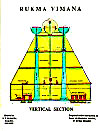 Strong and durable must the body of the
Vimana be made, like a
great flying bird of light material. Inside one must put the
mercury engine with its iron heating apparatus underneath.
By means of the power latent in the mercury which sets the
driving whirlwind in motion, a man sitting inside may travel
a great distance in the sky. The movements of the Vimana are
such that it can vertically ascend, vertically descend, move
slanting forwards and backwards. With the help of the
machines human beings can fly in the air and heavenly beings
can come down to earth. Strong and durable must the body of the
Vimana be made, like a
great flying bird of light material. Inside one must put the
mercury engine with its iron heating apparatus underneath.
By means of the power latent in the mercury which sets the
driving whirlwind in motion, a man sitting inside may travel
a great distance in the sky. The movements of the Vimana are
such that it can vertically ascend, vertically descend, move
slanting forwards and backwards. With the help of the
machines human beings can fly in the air and heavenly beings
can come down to earth.
The Hakatha (Laws of the Babylonians) states quite
unambiguously: The privilege of operating a flying machine is great.
The knowledge of flight is among the most ancient of our
inheritances. A gift from 'those from upon high'. We received it
from them as a means of saving many lives.
More fantastic still is the information given in the ancient Chaldean
work, The Sifrala, which contains over one hundred
pages of technical details on building a flying machine. It contains
words which translate as graphite rod, copper coils, crystal
indicator, vibrating spheres, stable angles, etc.
('Ancient
Indian Aircraft Technology' From The Anti-Gravity Handbook by D.
Hatcher Childress).
Many researchers into the UFO enigma tend to overlook a very
important fact. While it assumed that most flying saucers are of
alien, or perhaps Governmental Military origin, another possible
origin of UFOs is ancient India and
Atlantis. What we know
about ancient Indian flying vehicles comes from ancient Indian
sources; written texts that have come down to us through the
centuries. There is no doubt that most of these texts are authentic;
many are the well known ancient Indian Epics themselves, and there
are literally hundreds of them. Most of them have not even been
translated into English yet from the old Sanskrit.
The Indian Emperor Ashoka started a "Secret
Society of the Nine Unknown Men": great Indian scientists
who were supposed to catalogue the many sciences. Ashoka kept their
work secret because he was afraid that the advanced science
catalogued by these men, culled from ancient Indian sources, would
be used for the evil purpose of war, which Ashoka was strongly
against, having been converted to Buddhism after defeating a rival
army in a bloody battle. The "Nine Unknown Men"
wrote a total of
nine books, presumably one each. Book number was "The Secrets of
Gravitation!". This book, known to historians, but not actually seen
by them dealt chiefly with "gravity control." It is presumably still
around somewhere, kept in a secret library in India, Tibet or else
where (perhaps even in North America somewhere). One can certainly
understand Ashoka's reasoning for wanting to keep such knowledge a
secret, assuming it exists. Ashoka was also aware of devastating
wars using such advanced vehicles and other "futuristic weapons"
that had destroyed the ancient Indian "Rama Empire" several thousand
years before.
Only a few years ago, the Chinese discovered some Sanskrit documents
in
Lhasa, Tibet and sent them to the University of
Chandrigarh to be translated. Dr. Ruth Reyna of the
University said recently that the documents contain directions for
building interstellar spaceships! Their method of propulsion, she
said, was "anti- gravitational" and was based upon a system
analogous to that of "laghima," the unknown power of
the ego existing in man's physiological makeup, "a centrifugal force
strong enough to counteract all gravitational pull."
According to Hindu Yogis, it is this "laghima" which enables a
person to levitate. Dr. Reyna said that on board these machines, which were called
"Astras" by the text, the ancient Indians could have sent a
detachment of men onto any planet, according to the document, which
is thought to be thousands of years old. The manuscripts were also
said to reveal the secret of "antima", "the cap of invisibility" and
"garima", "how to become as heavy as a mountain of lead".
Naturally, Indian scientists did not take the texts very seriously,
but then became more positive about the value of them when the
Chinese announced that they were including certain parts of the data
for study in their space program!. This was one of the first
instances of a government admitting to be researching anti-gravity.
The manuscripts did not say definitely that interplanetary travel
was ever made but did mention, of all things, a planned trip to the
Moon, though it is not clear whether this trip was actually carried
out.
However, one of the great Indian epics, the Ramayana, does have a
highly detailed story in it of a trip to the moon in a Vimana (or
"Astra"), and in fact details a battle on the moon with an "Asvin"
(or
Atlantean) airship. This is but a small bit of recent
evidence of anti-gravity and aerospace technology used by Indians.
To really understand the technology, we must go much further back in
time.
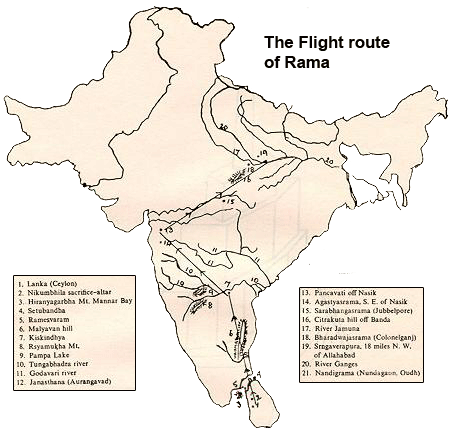
Flight Route of Rama (source:
Vimana in Ancient India - By Dileep Kumar Kanjilal
).
The so-called "Rama Empire" of Northern India and Pakistan developed
at least fifteen thousand years ago on the Indian subcontinent and
was a nation of many large, sophisticated cities, many of which are
still to be found in the deserts of Pakistan, northern, and western
India.
Rama existed, apparently, parallel to the Atlantean
civilization in the mid- Atlantic Ocean, and was ruled by
"enlightened Priest-Kings" who governed the cities.
The seven greatest capital cities of Rama were known in classical
Hindu texts as The Seven Rishi Cities According to ancient Indian
texts, the people had flying machines which were called "Vimanas."
The ancient Indian epic describes a Vimana as a double deck,
circular aircraft with portholes and a dome, much as we would
imagine a flying saucer. It flew with the "speed of the wind" and
gave forth a "melodious sound." There were at least four different
types of Vimanas; some saucer shaped, others like long cylinders
("cigar shaped airships").
The ancient Indian texts on Vimanas are so numerous, it would take
volumes to relate what they had to say. The ancient Indians, who
manufactured these ships themselves, wrote entire flight manuals on
the control of the various types of Vimanas, many of which are still
in existence, and some have even been translated into English. The
Samaraanganasutraadhaara is a scientific treatise dealing with every
possible angle of air travel in a Vimana.
There are 230 stanzas dealing with the construction, take-off,
cruising for thousand of miles, normal and forced landings, and even
possible collisions with birds. In 1875, the Vaimanika Sastra, a
fourth century B.C. text written by Bharadwaj the Wise, using
even older texts as his source, was rediscovered in a temple in
India. It dealt with the operation of Vimanas and included
information on the steering, precautions for long flights,
protection of the airships from storms and lightning and how to
switch the drive to "solar energy" from a free energy source which
sounds like "anti-gravity."
The Vaimanika Sastra (or Vymaanika-Shaastra) has eight chapters with
diagrams, describing three types of aircraft, including apparatuses
that could neither catch on fire nor break. It also mentions 31
essential parts of these vehicles and 16 materials from which they
are constructed, which absorb light and heat; for which reason they
were considered suitable for the construction of Vimanas. This
document has been translated into English and is available by
writing the publisher: VYMAANIDASHAASTRA AERONAUTICS
(by
Maharishi Bharadwaaja, translated into English and edited, printed
and published by Mr. G. R.Josyer, Mysore, India, 1979).
G. R. Josyer is the director of the International Academy
of Sanskrit Investigation, located in Mysore. There seems to
be no doubt that Vimanas were powered by some sort of
"anti-gravity." Vimanas took off vertically, and were capable of
hovering in the sky, like a modern helicopter or dirigible.
 Bharadwaj the Wise refers to no less than seventy
authorities and 10 experts of air travel in antiquity. These sources
are now lost. Bharadwaj the Wise refers to no less than seventy
authorities and 10 experts of air travel in antiquity. These sources
are now lost.
Vimanas were kept in a Vimana Griha, a kind of hanger,
and were sometimes said to be propelled by a yellowish-white liquid,
and sometimes by some sort of mercury compound, though writers seem
confused in this matter.
It is most likely that the later writers on Vimanas, wrote as
observers and from earlier texts, and were understandably confused
on the principle of their propulsion.
The "yellowish- white liquid" sounds suspiciously like gasoline,
and perhaps Vimanas had a number of different propulsion sources,
including combustion engines and even "pulse-jet" engines.
It is interesting to note, that the Nazis developed the first
practical pulse-jet engines for their V-8 rocket "buzz bombs."
Hitler and the Nazi staff were exceptionally interested
in ancient India and Tibet and sent expeditions to both these places
yearly, starting in the 30's, in order to gather esoteric evidence
that they did so, and perhaps it was from these people that the
Nazis gained some of their scientific information!. According
to the
Dronaparva, part of the Mahabharata, and the
Ramayana, one Vimana described was shaped like a sphere and born along at great
speed on a mighty wind generated by mercury. It moved like a UFO,
going up, down, backwards and forwards as the pilot desired. In
another Indian source, the Samar, Vimanas were "iron machines,
well-knit and smooth, with a charge of mercury that shot out of the
back in the form of a roaring flame."
Another work called the Samaranganasutradhara describes how the
vehicles were constructed. It is possible that mercury did have
something to do with the propulsion, or more possibly, with the
guidance system. Curiously, Soviet scientists have discovered what
they call "age old instruments used in navigating cosmic vehicles"
in caves in Turkestan and the Gobi Desert.
The "devices" are hemispherical objects of glass or porcelain,
ending in a cone with a drop of mercury inside. It is evident that
ancient Indians flew around in these vehicles, all over Asia, to
Atlantis presumably; and even, apparently, to South America.
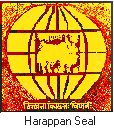 Writing found at
Mohenjodaro in Pakistan (presumed to be
one of the "Seven Rishi Cities of the Rama Empire") and still un
deciphered, has also been found in one other place in the world:
Easter Island!. Writing on Easter Island, called
Rongo-Rongo writing, is also un deciphered, and is uncannily
similar to the Mohenjodaro script. Was Easter Island an air base for
the Rama Empire's Vimana route?. Writing found at
Mohenjodaro in Pakistan (presumed to be
one of the "Seven Rishi Cities of the Rama Empire") and still un
deciphered, has also been found in one other place in the world:
Easter Island!. Writing on Easter Island, called
Rongo-Rongo writing, is also un deciphered, and is uncannily
similar to the Mohenjodaro script. Was Easter Island an air base for
the Rama Empire's Vimana route?.
In Tibet, no small distance, it speaks of the "fiery chariot" thus:
"Bhima flew along in his car, resplendent as the sun and loud as
thunder... The flying chariot shone like a flame in the night sky of
summer... it swept by like a comet... It was as if two suns were
shining. Then the chariot rose up and all the heaven brightened". In
the Mahavira of Bhavabhuti, a Jain text of the eighth century culled
from older texts and traditions, we read: "An aerial chariot, the
Pushpaka, conveys many people to the capital of Ayodhya. The sky is
full of stupendous flying-machines, dark as night, but picked out by
lights with a yellowish glare."
The Vedas, ancient Hindu poems, thought to be the oldest of all the
Indian texts, describe Vimanas of various shapes and sizes: the
"ahnihotravimana" with two engines, the "elephant-vimana" with more
engines, and other types named after the kingfisher, ibis and other
animals. Unfortunately, Vimanas, like most scientific discoveries,
were ultimately used for war. Atlanteans used their flying machines,
"Vailixi," a similar type of aircraft, to literally try and
subjugate the world, it would seem, if Indian texts are to be
believed.
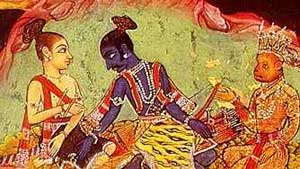 The Atlanteans, known as "Asvins" in the Indian
writings, were apparently even more advanced technologically than
the Indians, and certainly of a more war-like temperament. Although
no ancient texts on Atlantean Vailixi are known to exist, some
information has come down through esoteric, "occult" sources which
describe their flying machines. Similar, if not identical to
Vimanas, Vailixi were generally "cigar shaped" and had the
capability of maneuvering underwater as well as in the atmosphere or
even outer space. Other vehicles, like Vimanas, were saucer shaped,
and could apparently also be submerged. The Atlanteans, known as "Asvins" in the Indian
writings, were apparently even more advanced technologically than
the Indians, and certainly of a more war-like temperament. Although
no ancient texts on Atlantean Vailixi are known to exist, some
information has come down through esoteric, "occult" sources which
describe their flying machines. Similar, if not identical to
Vimanas, Vailixi were generally "cigar shaped" and had the
capability of maneuvering underwater as well as in the atmosphere or
even outer space. Other vehicles, like Vimanas, were saucer shaped,
and could apparently also be submerged.
According to Eklal Kueshana, author of "The Ultimate Frontier,"
in an
article he wrote in 1966:
Vailixi were first developed in Atlantis 20,000 years ago, and the
most common ones are "saucer shaped of generally trapezoidal cross-
section with three hemispherical engine pods on the underside. They
use a mechanical antigravity device driven by engines developing
approximately 80,000 horse power. The Ramayana, Mahabharata and
other texts speak of the hideous war that took place, some ten or
twelve thousand years ago between Atlantis and Rama using weapons of
destruction that could not be imagined by readers until the second
half of this century.
The ancient Mahabharata, one of the sources on Vimanas, goes on to
tell the awesome destructiveness of the war:
"...(the weapon was) a single projectile charged with all the power
of the Universe. An incandescent column of smoke and flame as bright
as the thousand suns rose in all its splendor. An iron thunderbolt,
a gigantic messenger of death, which reduced to ashes the entire
race of the Vrishnis and the Andhakas. The corpses were so burned as
to be unrecognizable. The hair and nails fell out; pottery broke
without apparent cause, and the birds turned white.... after a few
hours all foodstuffs were infected.... to escape from this fire, the
soldiers threw themselves in streams to wash themselves and their
equipment..."
It would seem that the Mahabharata is describing an
atomic war!.
References like this one are not isolated; but battles, using a
fantastic array of weapons and aerial vehicles are common in all the
epic Indian books.
One even describes a Vimana-Vailix battle on the Moon!. The
above section very accurately describes what an atomic explosion
would look like and the effects of the radioactivity on the
population. Jumping into water is the only respite. When the Rishi
City of
Mohenjodaro was excavated by archaeologists in the last
century, they found skeletons just lying in the streets, some of
them holding hands, as if some great doom had suddenly overtaken
them. These skeletons are among the most radioactive ever found, on
a par with those found at Hiroshima and Nagasaki. Ancient cities
whose brick and stonewalls have literally been vitrified, that
is-fused together, can be found in India, Ireland, Scotland, France,
Turkey and other places. There is no logical explanation for the vitrification of stone forts and cities, except from an atomic
blast.
Further more, at Mohenjo-Daro, a well planned city laid on a grid,
with a plumbing system superior to those used in Pakistan and India
today, the streets were littered with "black lumps of glass." These
globs of glass were discovered to be clay pots that had melted under
intense heat! With the cataclysmic sinking of Atlantis and the
wiping out of Rama with atomic weapons, the world collapsed into a
"stone age" of sorts, and modern history picks up a few thousand
years later Yet, it would seem that not all the Vimanas and
Vailixi
of Rama and Atlantis were gone. Built to last for thousands of
years, many of them would still be in use, as evidenced by Ashoka's
"Nine Unknown Men" and the Lhasa manuscript.
That secret societies or "Brotherhoods" of exceptional, "enlightened"
human beings would have preserved these inventions and the knowledge
of science, history, etc., does not seem surprising. Many well known
historical personages including Jesus, Buddah, Lao Tzu,
Confucious, Krishna, Zoroaster, Mahavira, Quetzalcoatl, Akhenaton,
Moses, and more recent inventors and of course many other people
who will probably remain anonymous, were probably members of such a
secret organization.
It is interesting to note that when Alexander the Great
invaded India more than two thousand years ago, his historians
chronicled that at one point they were attacked by "flying, fiery
shields" that dove at his army and frightened the cavalry. These
"flying saucers" did not use any atomic bombs or beam weapons on
Alexander's army however, perhaps out of benevolence, and Alexander
went on to conquer India. It has been suggested by many writers that
these "Brotherhoods" keep some of their
Vimanas and Vailixi in
secret caverns in Tibet or some other place is Central Asia, and the
Lop Nor Desert in western China is known to be the center of a great
UFO mystery. Perhaps it is here that many of the airships are
still kept, in underground bases much as the Americans, British and
Soviets have built around the world in the past few decades. Still,
not all UFO activity can be accounted for by old
Vimanas making
trips to the Moon for some reason. Unknown alloys have been revealed
in the ancient palm leaf manuscripts.
The writer and Sanskrit scholar Subramanyam Iyer has spent many
years of his life deciphering old collections of palm leaves found
in the villages of his native Karnataka in southern India. One of
the palm leaf manuscripts they intend to decipher is the Amsu
Bodhini, which, according to an anonymous text of 1931,
contains information about the planets; the different kinds of
light, heat, color, and electromagnetic fields; the methods used to
construct machines capable of attracting solar rays and, in turn, of
analyzing and separating their energy components; the possibility of
conversing with people in remote places and sending messages by
cable; and the manufacture of machines to transport people to other
planets!
Contributed by John Burrows
In one episode, for example, the Vrishnis, a tribe whose warriors
include the hero Krishna, are beset by the forces of a leader named
Salva.
"The cruel Salva had come mounted on the Saubha chariot that can go
anywhere, and from it he killed many valiant Vrishni youths and
evilly devastated all city parks."
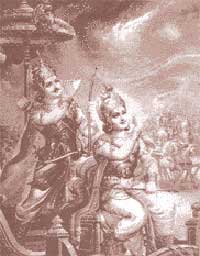 The Saubha is at once Salva's city, flagship, and battle headquarters.
In it, he can fly wherever he chooses. Fortunately, the Vrishni
heroes are similarly well equipped, and at one point have Salva at
their mercy. The hero Pradyumna is about to finish him off with a
special weapon, when the highest gods stop him "Not a man in battle
is safe from this arrow," they say, and declare that Salva will fall
to Krishna. The Saubha is at once Salva's city, flagship, and battle headquarters.
In it, he can fly wherever he chooses. Fortunately, the Vrishni
heroes are similarly well equipped, and at one point have Salva at
their mercy. The hero Pradyumna is about to finish him off with a
special weapon, when the highest gods stop him "Not a man in battle
is safe from this arrow," they say, and declare that Salva will fall
to Krishna.
Krishna took to the sky in pursuit of Salva, but his
Saubha clung to
the sky at a leagues length... He threw at me rockets, missiles,
spears, spikes, battleaxes, three-bladed javelins, flame-throwers,
without pausing... The sky... seemed to hold a hundred suns, a
hundred moons... and a hundred myriad stars. Neither day nor night
could be made out, or the points of a compass.
Krishna, however, wards off Salva's attack with what sounds like
antiballistic missiles; I warded them off as they loomed towards me.
With my swift-striking shafts, as they flashed through the sky, And I
cut them into two or three pieces with mine -- There was a great din
in the sky above. However, the Saubha becomes invisible.
Krishna
then loads a special weapon, perhaps an ancient version of a smart
bomb? I quickly laid on an arrow, which killed by seeking out sound,
to kill them... All the Danavas [Salva's troops] who had been
screeching lay dead, killed by the blazing sun like arrows that were
triggered by sound.
However, the Saubha itself escaped the attack. Krishna fires his
"favorite fire weapon" at it, a discus shaped like the
"haloed sun".
The discus breaks the Saubha in two, and the city falls from the
sky, killing Salva. This is the end of the Mahabharata. One of the
most intriguing thing about it is that the use of Pradyumna's
special arrow, from which "not a man in battle is safe", was
outlawed by the gods. What sort of weapon could this be?
Another chapter, describing the use of the Agneya weapon by the hero
Adwattan.
When the weapon, a "blazing missile of smokeless fire" is unleashed;
dense arrows of flame, like a great shower, issued forth upon
creation, encompassing the enemy... A thick gloom swiftly settled
upon the Pandava hosts. All points of the compass were lost in
darkness. Fierce winds began to blow. Clouds roared upward,
showering dust and gravel. Birds coked madly... the very elements
seemed disturbed. The sun seemed to waver in the heavens. The earth
shook, scorched by the terrible violent heat of this weapon.
Elephants burst into flame and ran to and fro in a frenzy... over a
vast area, other animals crumpled to the ground and died. From all
points of the compass the arrows of flame rained continuously and
fiercely.
And if that sounded like a firestorm, then a similar weapon fired by
Gurkha sounds like nothing less than a nuclear blast complete with
radioactive fallout;
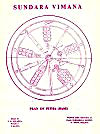 Gurkha, flying in his swift and powerful Vimana, hurled against the
three cities of the Vrishnis and Andhakas a single projectile
charged with all the power of the universe. Gurkha, flying in his swift and powerful Vimana, hurled against the
three cities of the Vrishnis and Andhakas a single projectile
charged with all the power of the universe.
An incandescent column of smoke and fire, as brilliant as ten thousand
suns, rose in all its splendor. It was the unknown weapon, the iron
thunderbolt, a gigantic messenger of death which reduced to ashes
the entire race of Vrishnis and Andhakas.
The corpses were so burnt they were no longer recognizable. Hair and
nails fell out. Pottery broke without cause... Foodstuffs were
poisoned.
To escape, the warriors threw themselves in streams to wash themselves
and their equipment.
|

 The Puspaka car that resembles the Sun and belongs to my brother
was brought by the powerful Ravan; that aerial and excellent
car going everywhere at will.... that car resembling a
bright cloud in the sky. ".. and the King [Rama] got
in, and the excellent car at the command of the Raghira,
rose up into the higher atmosphere."
The Puspaka car that resembles the Sun and belongs to my brother
was brought by the powerful Ravan; that aerial and excellent
car going everywhere at will.... that car resembling a
bright cloud in the sky. ".. and the King [Rama] got
in, and the excellent car at the command of the Raghira,
rose up into the higher atmosphere."


 Bharadwaj the Wise refers to no less than seventy
authorities and 10 experts of air travel in antiquity. These sources
are now lost.
Bharadwaj the Wise refers to no less than seventy
authorities and 10 experts of air travel in antiquity. These sources
are now lost.
 Writing found at
Writing found at
 The Atlanteans, known as "Asvins" in the Indian
writings, were apparently even more advanced technologically than
the Indians, and certainly of a more war-like temperament. Although
no ancient texts on Atlantean Vailixi are known to exist, some
information has come down through esoteric, "occult" sources which
describe their flying machines. Similar, if not identical to
Vimanas, Vailixi were generally "cigar shaped" and had the
capability of maneuvering underwater as well as in the atmosphere or
even outer space. Other vehicles, like Vimanas, were saucer shaped,
and could apparently also be submerged.
The Atlanteans, known as "Asvins" in the Indian
writings, were apparently even more advanced technologically than
the Indians, and certainly of a more war-like temperament. Although
no ancient texts on Atlantean Vailixi are known to exist, some
information has come down through esoteric, "occult" sources which
describe their flying machines. Similar, if not identical to
Vimanas, Vailixi were generally "cigar shaped" and had the
capability of maneuvering underwater as well as in the atmosphere or
even outer space. Other vehicles, like Vimanas, were saucer shaped,
and could apparently also be submerged. The Saubha is at once Salva's city, flagship, and battle headquarters.
In it, he can fly wherever he chooses. Fortunately, the Vrishni
heroes are similarly well equipped, and at one point have Salva at
their mercy. The hero Pradyumna is about to finish him off with a
special weapon, when the highest gods stop him "Not a man in battle
is safe from this arrow," they say, and declare that Salva will fall
to Krishna.
The Saubha is at once Salva's city, flagship, and battle headquarters.
In it, he can fly wherever he chooses. Fortunately, the Vrishni
heroes are similarly well equipped, and at one point have Salva at
their mercy. The hero Pradyumna is about to finish him off with a
special weapon, when the highest gods stop him "Not a man in battle
is safe from this arrow," they say, and declare that Salva will fall
to Krishna.
